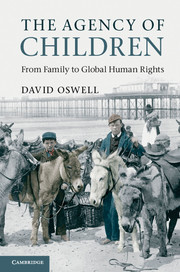Book contents
- Frontmatter
- Contents
- Figures
- Acknowledgements
- Part I Introduction
- Part II Social theories of children and childhood
- Part III
- 6 Family and household
- 7 School and education
- 8 Crime and criminality
- 9 Health and medicine
- 10 Play and consumer culture
- 11 Political economies of labour
- 12 Rights and political participation
- Part IV Conclusions
- Bibliography
- Index
8 - Crime and criminality
Published online by Cambridge University Press: 05 April 2013
- Frontmatter
- Contents
- Figures
- Acknowledgements
- Part I Introduction
- Part II Social theories of children and childhood
- Part III
- 6 Family and household
- 7 School and education
- 8 Crime and criminality
- 9 Health and medicine
- 10 Play and consumer culture
- 11 Political economies of labour
- 12 Rights and political participation
- Part IV Conclusions
- Bibliography
- Index
Summary
This chapter explores the way in which children and young people have been considered as criminal subjects, but also as the victims of criminality. All of us on a reasonably regular basis commit a criminal offence, whether dropping a sweet wrapper, playing music too loud at night-time, watering the garden during a period of restriction and so on. Some offences are seen to be more serious. Across the range of crimes committed, some people are typified as being more likely to commit more serious crime. Across the range of crimes, some people are more heavily policed and sentenced and more likely to be caught up in the judicial system. The visible range of illegalities that are, and have been, committed by children and young people is large and wide and is dependent on legislation, judicial process, policing, cultural and many other factors. In many cases children are the victims of crime, whether committed by adults or other children. That said, both sociological research and governmental intervention have tended to more consistently focus on a limited range of issues and problems. In this chapter I consider the changing nature of that limited range of problems. I focus on the construction of children and criminality in terms of the figurations of the delinquent (as both ‘in danger’ and ‘dangerous’) and the gang. In mapping some of the discussions in these areas, the chapter follows a trajectory that sees marked distinctions, but also continuities, from a criminological and penal discourse in the context of nineteenth-century welfarism, hygienism and moralism to a late modern configuration in the context of neoliberal and neoconservative ideological projects and a series of technologies and technical discourses on risk, probability and prevention. Moreover, each of these strategies of figuration is marked by complex scalings across local, national and transnational, as well as dynamics across expert and popular mediations. Thus, each strategy rests, for example, on highly overdetermined figures such as the neglected child, the youth gang located in the black or Hispanic ghetto, or the genetic and somatic criminal identified in the nursery (which we consider in the following chapter). Of particular significance is the territorialisation of children and criminality as a hybrid confluence of public and domestic.
- Type
- Chapter
- Information
- The Agency of ChildrenFrom Family to Global Human Rights, pp. 139 - 161Publisher: Cambridge University PressPrint publication year: 2012



